|
|
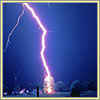

|
|
cloud-to-ground
This is the archetypal lightning bolt, one that arcs out of the sky and smites
the ground with a great, often flickering flash of light. Lightning is the
sudden release of built-up charge stored in an electric field, though exactly
what triggers it remains a mystery (see "How Lightning Works").
|
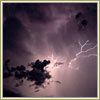

|
|
cloud discharge
This is lightning that occurs within a thundercloud, between two thunderclouds,
or from a thundercloud to the air. Experts think most cloud discharges take
place within an individual cloud, though few data exist to confirm that belief.
Cloud discharges are certainly more common than the cloud-to-ground variety: 10
or more cloud flashes may occur before the first one that strikes the earth.
|
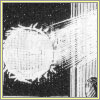

|
|
ball lightning
No scientific documentation such as photos, videos, or other recordings of ball
lightning exist, so experts have had to rely on eyewitness accounts,
which have been numerous. Judging from such accounts, balls of lightning are
typically between a golfball and a basketball in size, about as bright as a
60-watt light bulb, and often red, orange, or yellow in color. Observed
shooting through the air, across the ground, and or even into houses, they are
fleeting, generally lasting a few seconds before vanishing gradually or
abruptly.
|


|
|
blue jet
Blue jets shoot upward from the tops of thunderclouds. This remoteness, and the
fact that they last but a few hundred milliseconds at most, perhaps accounts
for why they were not discovered until 1994. The color of sapphires, they are
cone-shaped in structure and extend for many miles. Like sprites and elves,
blue jets provide a mechanism for energy transfer from lightning and
thunderstorms to regions of the atmosphere between thunderclouds and the lower
ionosphere.
|
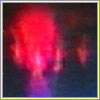

|
|
red sprites
Red sprites occur above large thunderstorm systems and are generally associated
with larger positive cloud-to-ground flashes far below. They are most luminous
very high up in the atmosphere, between altitudes of about 25 and 55 miles. Yet
even at their most luminous, they are very hard to see, in part because they
last for only a few thousandths of a second. Red in color and often bearing
faint bluish tendrils extending downward, sprites come in several shapes,
designated by colorful names like "carrot," "angel," and "columniform."
|
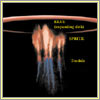

|
|
elves
Like celestial halos, elves are circles of light that appear some 50 miles or
more above thunderstorms. Triggered by lightning flashes far below, these
ephemeral discs spread out radially across the bottom of the ionosphere in the
briefest instant, expanding up to hundreds of miles in diameter in less than a
millisecond. Experts believe elves are caused by lightning processes that
accelerate electrons in the lower ionosphere.
|
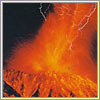

|
|
volcanic lightning
Lightning-like discharges are sometimes observed during volcanic eruptions,
with no thunderstorm anywhere nearby. Hundreds or even thousands of feet in
length, these bolts can flash to the ground or remain entirely within the ash
cloud above the volcano. Here, lightning flashes during an eruption of Japan's
Sakurajima Volcano in 1991.
|
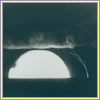

|
|
nuclear lightning
Hydrogen-bomb explosions can generate their own lightning. Ground-level
detonations, like this 1952 test of an experimental thermonuclear device on
Eniwetok in the South Pacific, cause a negative charge to be deposited in the
atmosphere, resulting in long discharges not produced by clouds. This is a
frame from movie footage shot at a distance of about 18 miles from ground zero.
The lightning channels have been enhanced for visibility.
|
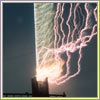

|
|
triggered lightning
"Triggering lightning at will, at a predetermined place and time, is the old
Promethean dream which seems more related to legend than to science," lightning
expert Pierre Hubert has written. Yet the technique has taught scientists much
about lightning processes and effects. Here, a rocket trailing a thin, grounded
copper wire was launched into a thundercloud, triggering a series of lightning
bolts that followed the path of the wire, which was vaporized in the process
(see smoke-like vapor). Wind has separated the individual bolts.
|
|
|


